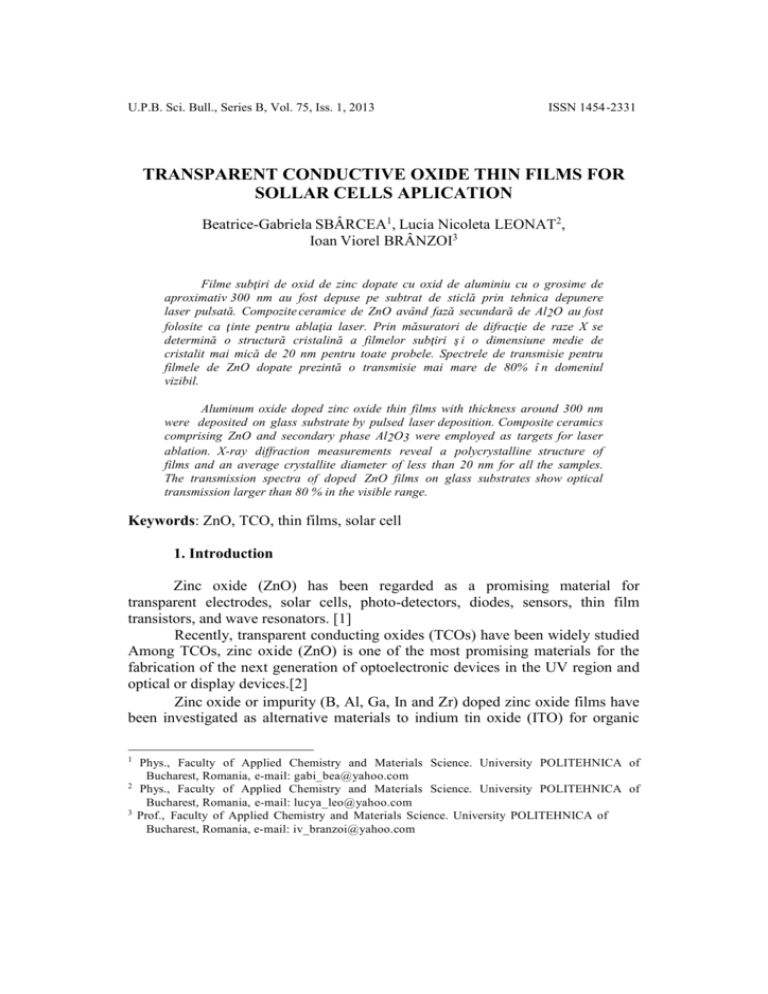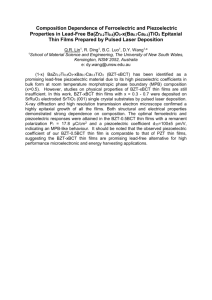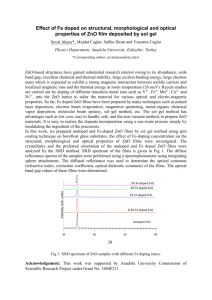transparent conductive oxide thin films for sollar cells aplication
advertisement

U.P.B. Sci. Bull., Series B, Vol. 75, Iss. 1, 2013 ISSN 1454-2331 TRANSPARENT CONDUCTIVE OXIDE THIN FILMS FOR SOLLAR CELLS APLICATION Beatrice-Gabriela SBÂRCEA1, Lucia Nicoleta LEONAT2, Ioan Viorel BRÂNZOI3 Filme subţiri de oxid de zinc dopate cu oxid de aluminiu cu o grosime de aproximativ 300 nm au fost depuse pe subtrat de sticlă prin tehnica depunere laser pulsată. Compozite ceramice de ZnO având fază secundară de Al2O au fost folosite ca ţinte pentru ablaţia laser. Prin măsuratori de difracţie de raze X se determină o structură cristalină a filmelor subţiri ş i o dimensiune medie de cristalit mai mică de 20 nm pentru toate probele. Spectrele de transmisie pentru filmele de ZnO dopate prezintă o transmisie mai mare de 80% î n domeniul vizibil. Aluminum oxide doped zinc oxide thin films with thickness around 300 nm were deposited on glass substrate by pulsed laser deposition. Composite ceramics comprising ZnO and secondary phase Al2O3 were employed as targets for laser ablation. X-ray diffraction measurements reveal a polycrystalline structure of films and an average crystallite diameter of less than 20 nm for all the samples. The transmission spectra of doped ZnO films on glass substrates show optical transmission larger than 80 % in the visible range. Keywords: ZnO, TCO, thin films, solar cell 1. Introduction Zinc oxide (ZnO) has been regarded as a promising material for transparent electrodes, solar cells, photo-detectors, diodes, sensors, thin film transistors, and wave resonators. [1] Recently, transparent conducting oxides (TCOs) have been widely studied Among TCOs, zinc oxide (ZnO) is one of the most promising materials for the fabrication of the next generation of optoelectronic devices in the UV region and optical or display devices.[2] Zinc oxide or impurity (B, Al, Ga, In and Zr) doped zinc oxide films have been investigated as alternative materials to indium tin oxide (ITO) for organic 1 2 3 Phys., Faculty of Applied Chemistry and Materials Science. University POLITEHNICA of Bucharest, Romania, e-mail: gabi_bea@yahoo.com Phys., Faculty of Applied Chemistry and Materials Science. University POLITEHNICA of Bucharest, Romania, e-mail: lucya_leo@yahoo.com Prof., Faculty of Applied Chemistry and Materials Science. University POLITEHNICA of Bucharest, Romania, e-mail: iv_branzoi@yahoo.com 150 Beatrice-Gabriela Sbârcea, Lucia Nicoleta Leonat, Ioan Viorel Brânzoi light emitting diodes (OLEDs) because zinc oxide is nontoxic, inexpensive and abundant. In comparison to ITO, ZnO has the advantages of low cost, nontoxic and with good thermal stability. Zinc oxide is a semiconductor, which is highly transparent in the visible region with a wide and direct band gap of about 3.37 eV at room temperature and a high exciton binding energy of 60 eV. Generally, undoped ZnO thin films exhibit n-type conduction with a background electron concentration as high as 1021 cm-3 [3]. Aluminium, indium and gallium oxides have been reported as effective n- type dopants to increase the electrical conductivity of pure zinc oxide. [4] Recently, aluminium oxide doped zinc oxide (AZO) thin films have been used as windows and contact layers for thin film solar cells. [5] Among the several fabrication techniques, pulsed laser deposition (PLD) has attracted much attention because the fabrication process is quite suitable for optoelectronic devices using the ZnO transparent electrode. The composition of films grown by PLD is quite close to that of the target. [6] PLD films may be crystallized at lower deposition temperature in comparison with other physical vapor deposition techniques due to the high kinetic energies of the ionized and ejected species in the laser plumes. [3] In this study, Al2O3 doped ZnO thin films were prepared using PLD, On glass substrate, at different substrate temperatures, ranging from room temperature to 500oC. The crystallographic structure and optical properties of the films prepared with different growth parameters will be discussed. 2. Experimental AZO thin films were prepared on glass substrates at different temperature by pulsed laser deposition, using a ceramic target. The target of AZO was fabricated using high-purity ZnO (99.99%) doped with 3wt% Al2O3 (99.99%). The target was obtained by manually grinding the powder mixture for 30 min, pressing the powders to pellets at the pressure of 3.5 tons/cm2, and sintering of pellets in air. A KrF excimer laser (λ = 248 nm, pulse duration 20 ns, fluence 2 J/cm2, pulse repetition rate 10 Hz) was used for film growth. An oxygen gas background with pressure p(O2) = 10-3 mbar is employed during PLD and postdeposition cool-down. The AZO films were produced by ablating ZnO targets containing 3 wt% -3wt% Al2O3. Doped ZnO thin films were characterized by X-ray diffraction (D8 Discover AXS-Bruker diffractometer) to evidence the crystal structure. The surface morphology was observed by atomic force microscopy (AFM from Veeco). The optical transmission measurements were performed using a UV-VIS spectrophotometer (Jasco 570) and the thin films structure was investigated with scanning electron microscopy (SEM, Auriga from Zeiss). Transparent conductive oxide thin films for sollar cells aplication 151 3. Results and discussion Fig. 1 shows the XRD patterns of AZO films deposited at different temperature, ranging from room temperature to 500oC. The X-ray diffraction patterns were obtained for 2θ values from 10 deg. to 70 deg. The AZO thin films deposited at room temperature were amorphous while the well crystallized polycrystalline phase appears at temperatures above 300oC. All samples containing films deposited over 300°C temperature presented strong c-axis texture, perpendicular to the substrate with a pronounced [002] diffraction peak at approximately 2θ = 34.4 degrees. The [002] peak intensity increased with the increase of the temperature. In addition, two small peaks [102] and [103], appear at approximately 48,8 degrees and 63 degrees, respectively. The peak intensity of [102] and [103] peaks also increase with increasing the temperature. XRD patterns show that the deposited films were crystallized in hexagonal phase, namely a wurtzite structure. 3000 ZnO 2000 ZnO ZnO o AZO 3% 500 C o AZO 3% 450 C o AZO 3% 400 C 1000 o AZO 3% 350 C o AZO 3% 300 C AZO 3% room temperature 0 10 20 30 40 50 60 70 Fig.1 X-ray diffraction patterns of AZO thin films deposited at different substrate temperature X-ray diffraction parameters are presented in table 1. 152 Beatrice-Gabriela Sbârcea, Lucia Nicoleta Leonat, Ioan Viorel Brânzoi Table 1 X-ray diffraction data of the AZO thin films at different temperatures Sample name 2 Miller Full θ index (hkl) width at half (nm) [ maximum deg] (FWHM) AZO 3% 300 oC 00 3 1.011 2 00 4.37 AZO 3% 350 oC 3 0.521 22 2 00 4.38 AZO 3% 400 oC 3 0.521 .96 2 00 4.40 AZO 3% 450 oC 3 0.470 .97 2 00 4.46 AZO 3% 500 oC 3 0.530 .70 2 4.48 .70 D 8. 15 15 17 15 The grain size of the film from the XRD data was calculated using the Debye –Scherrer formula: D 0.9 / B cos (1) where D is the grain size of the crystallite, λ (1.54059 Å) is the wavelength of the X-rays used, B is the broadening of diffraction line measured at the half of its maximum intensity in radians and θ is the angle of diffraction. The transmittance of the AZO thin films, shown in Fig. 2 is an important factor for TCO applications, because applications such as solar cells require a wide bandgap to avoid unwanted absorption of the solar spectra. Fig.2 Optical transmission of AZO thin films deposited at different substrate temperature The transparency of the films increased in the visible range (>80%) after aluminum oxide was introduced in the films. The widening of the optical band- gap with the substrate temperature is originated by the increase of the electron concentration caused by Al2O3 doping [7]. Transparent conductive oxide thin films for sollar cells aplication 153 The surface topography and SEM micrographs are being presented in the next images, Fig. 3. 154 Beatrice-Gabriela Sbârcea, Lucia Nicoleta Leonat, Ioan Viorel Brânzoi Fig. 3. SEM and AFM images of AZO thin film deposited at different substrate temperatures starting from room temperature (top), 300oC, 350oC, 400oC, 450oC, 500 oC. (bottom) The surfaces investigated by AFM look flat and very few sharp peaks appear in the domain. The root-mean square (RMS) roughness value of the AZO thin films fabricated in the range of 27-500o C does not vary linearly with the temperature but the surfaces become smoother with temperature. Increasing the temperature also causes the increase of the droplets sizes, which may be due to the coalescence of the grains. However, the maximum value for RMS roughness does not exceed 5 nm for all samples studied. The RMS values are shown in the table 2. Table 2 The RMS values of roughness for the AZO thin films at different temperatures: Sample name Root Mean Square (RMS) roughness, AZO 3% room 2.34 nm temp AZO 3% 300 oC 4.48 o 1.46 AZO 3% 350 C o 2.96 AZO 3% 400 C o 0.82 AZO 3% 450 C o 1.29 AZO 3% 500 C Transparent conductive oxide thin films for sollar cells aplication 155 The surface morphologies of the films are also observed by FESEM, Fig. 3. The morphology of AZO films is found to be compact and continuous. Agglomeration-like micrograins arbitrarily dispersed on the surface can be observed. 4. Conclusions 3 wt% Al2O3 doped ZnO thin films were prepared on glass substrates by Pulsed Laser Deposition (PLD), with different substrate temperatures. The structural and optical properties of Al2O3 doped ZnO thin film have been investigated by X-ray diffraction, UV-Vis spectroscopy, FESEM and AFM techniques. X-ray diffraction studies show a polycrystalline wurtzite structure and a preferential orientation along the axis [002]. The crystallite size is around 18 nm. From the AFM and FESEM images, the surfaces investigated are smooth with very few droplets; the root mean square value of roughness for each sample does not decrease linearly with the temperature, nevertheless it is not higher than 5 nm. The optical transmittance is over 80%, which makes these AZO thin films good candidates for TCO application. Acknowledgement The work has been funded by the Sectoral Operational Programme Human Resources Development 2007-2013 of the Romanian Ministry of Labour, Family and Social Protection through the Financial Agreement POSDRU/88/1.5/S/60203. REFERENCES [1] D.H. Cho, J.H. Kim, B.M. Moon, Y.D. Jo, S.M. Koo, Control of a- and c- plane preferential orientations of ZnO thin films, Applied Surface Science, 255, 2009 pp 3480– 3484 [2] S.Ilican, M. Caglar, Y. Caglar, Determination of the thickness and optical constants of transparent indium-doped ZnO thin films by the envelope method, Materials Science, Vol. 25, No. 3, 2007, pp709-718 [3] S.M. Park, T. Ikegami, Kenji Ebihara, Paik-Kyun Shin, Structure and properties of transparent conductive doped ZnO films by pulsed laser deposition, Applied Surface Science 253, 2006, 1522-1527 [4] J.H. Shin, D.K. Shin, H.Y. Lee, J.Y. Lee, Properties of multilayer gallium and aluminum doped ZnO (GZO/AZO) transparent thin films deposited by pulsed laser deposition process, Transactions of Nonferrous Metals Society of China, Vol 21, Supplement 1, 2011, pp 96–99 [5] Y.S. Jung, Hyung WooH.W. Choi, K.H. Kim, Properties of AZO Thin Films f or Solar 156 Beatrice-Gabriela Sbârcea, Lucia Nicoleta Leonat, Ioan Viorel Brânzoi Cells Deposited on Polycarbonate Substrates, Journal of the Korean Physical Society, Vol. 55, No. 5, 2009, pp. 1945-1949 [6] S.M. Park, T. Ikegami, K. Ebihara, Investigation of Transparent Conductive Oxide AlDoped ZnO Films Produced by Pulsed Laser Deposition, Japanese Journal of Applied Physics, Vol. 44, No. 11, 2005, pp. 8027–8031 [7] Y. Liu, L.Zhao, J. Lian, Al-doped ZnO films by pulsed laser deposition at room temperature, Vacuum, Vol, 81, 2006 pp. 18–21 [8] D. Djouadi, A. Chelouche, A. Aksas, Amplification of the UV Emission of ZnO:Al Thin Films Prepared by Sol-Gel Method, Journal of Materials and Environmental Sciences 3, vol 3, 2012, pp. 585-590 [9] H. Kong, P. Yang, J. Chu, Processing Parameters and Property of AZO Thin Film Prepared by Magnetron Sputtering, Journal of Physics: Conference Series 276, 2011, pp 012170 [10] C. Weidenthaler , Pitfalls in the characterization of nanoporous and nanosized materials, Nanoscale, vol 3, 2011, pp 792-810 [11] S. Venkatachalam, Y. Kanno, S. Velumani, Characterization on pulsed laser deposited nanocrystalline ZnO thin films, Vacuum, vol 84, 2010, pp 1199–1203 [12] N. Hirahara, B. Onwona-Agyeman, M. Nakao, Preparation of Al-doped ZnO thin films as transparent conductive substrate in dye-sensitized solar cell, Thin Solid Films, Vol 520, Issue 6, 2012, pp 2123–2127 [13] Y.K. Tseng, G.J. Gao, S.C. Chien, Synthesis of c-axis preferred orientation ZnO:Al transparent conductive thin films using a novel solvent method, Thin Solid Films, Vol 518, Issue 22, 2010, pp 6259–6263 [14] J.N. Ding, C.B. Tan, N.Y. Yuan, X.W. Feng, X.Y. Chang, F. Ye, The Preparation and Properties of Al-Doped ZnO Thin Films as Transparent Electrodes for Solar Cell, Physics Procedia, Vol 32, 2012, Pages 789–794 [15] P. Gondoni, M. Ghidelli, F. Di Fonzo, V. Russo, P. Bruno, J. Martí-Rujas, C.E. Bottani, A. Li Bassi. C.S. Casari, Structural and functional properties of Al:ZnO thin films grown by Pulsed Laser Deposition at room temperature, Thin Solid Films, Vol 520, Issue 14, 2012, pp 4707–4711







